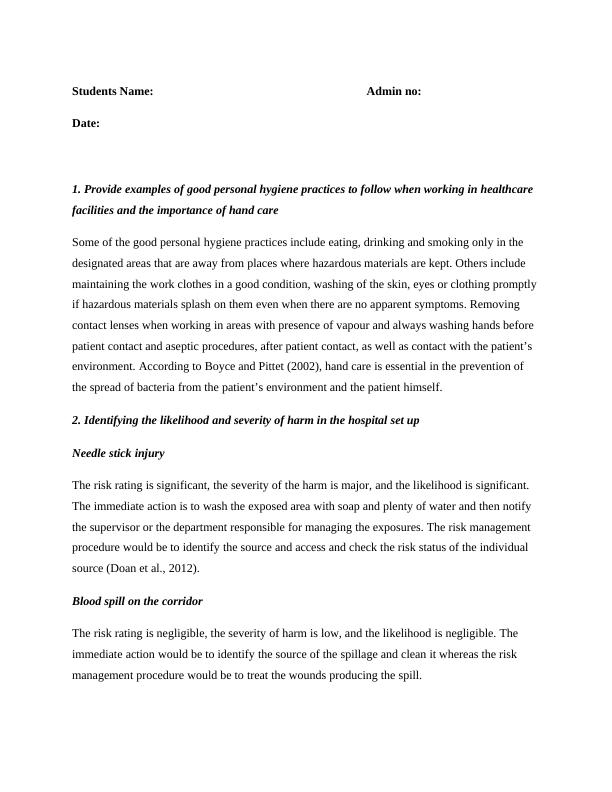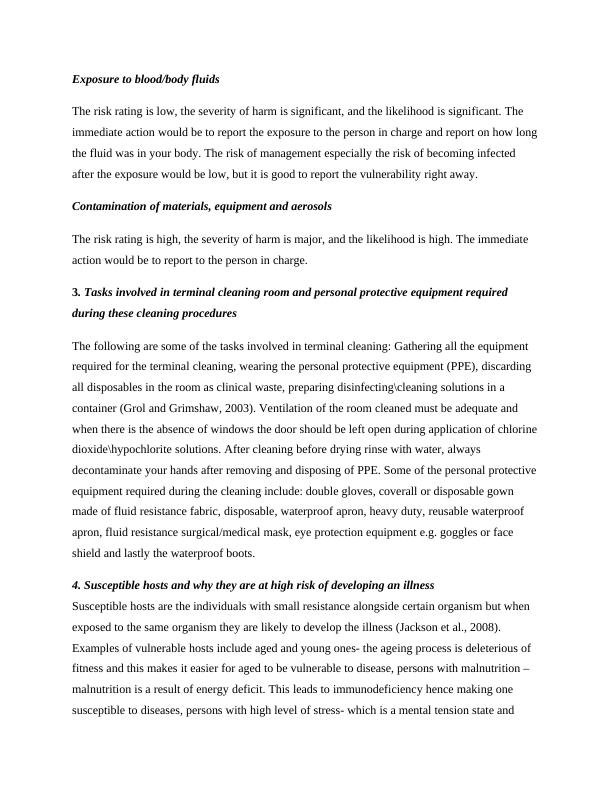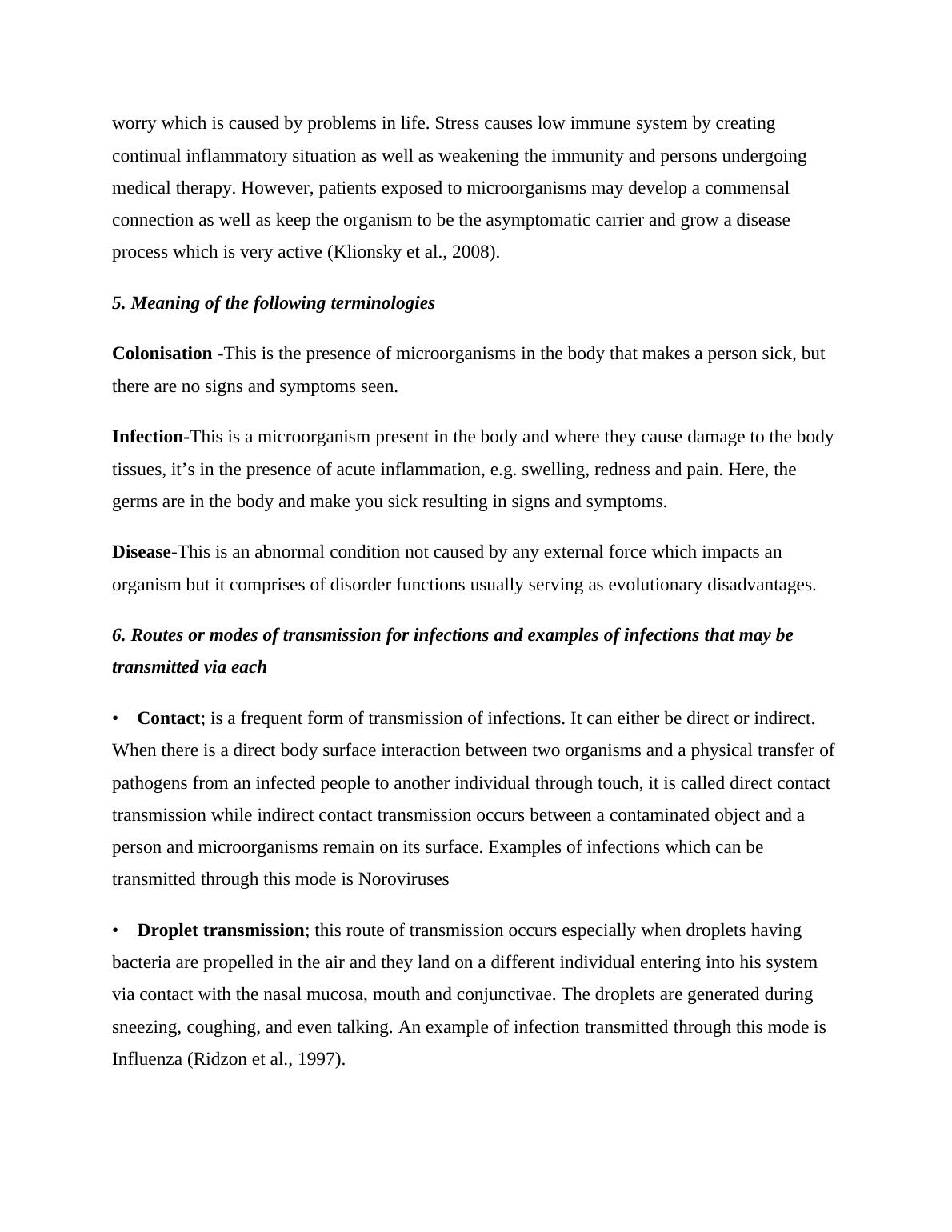HLTINF001 Assessment: Comply With Infection Prevention and Control Policies and Procedures
Added on 2020-04-13
7 Pages2166 Words84 Views
Students Name: Admin no:Date:1. Provide examples of good personal hygiene practices to follow when working in healthcare facilities and the importance of hand care Some of the good personal hygiene practices include eating, drinking and smoking only in the designated areas that are away from places where hazardous materials are kept. Others include maintaining the work clothes in a good condition, washing of the skin, eyes or clothing promptly if hazardous materials splash on them even when there are no apparent symptoms. Removing contact lenses when working in areas with presence of vapour and always washing hands before patient contact and aseptic procedures, after patient contact, as well as contact with the patient’s environment. According to Boyce and Pittet (2002), hand care is essential in the prevention of the spread of bacteria from the patient’s environment and the patient himself.2.Identifying the likelihood and severity of harm in the hospital set upNeedle stick injury The risk rating is significant, the severity of the harm is major, and the likelihood is significant. The immediate action is to wash the exposed area with soap and plenty of water and then notify the supervisor or the department responsible for managing the exposures. The risk management procedure would be to identify the source and access and check the risk status of the individual source (Doan et al., 2012). Blood spill on the corridorThe risk rating is negligible, the severity of harm is low, and the likelihood is negligible. The immediate action would be to identify the source of the spillage and clean it whereas the risk management procedure would be to treat the wounds producing the spill.

Exposure to blood/body fluidsThe risk rating is low, the severity of harm is significant, and the likelihood is significant. The immediate action would be to report the exposure to the person in charge and report on how longthe fluid was in your body. The risk of management especially the risk of becoming infected after the exposure would be low, but it is good to report the vulnerability right away.Contamination of materials, equipment and aerosolsThe risk rating is high, the severity of harm is major, and the likelihood is high. The immediate action would be to report to the person in charge. 3. Tasks involved in terminal cleaning room and personal protective equipment required during these cleaning proceduresThe following are some of the tasks involved in terminal cleaning: Gathering all the equipment required for the terminal cleaning, wearing the personal protective equipment (PPE), discarding all disposables in the room as clinical waste, preparing disinfecting\cleaning solutions in a container (Grol and Grimshaw, 2003). Ventilation of the room cleaned must be adequate and when there is the absence of windows the door should be left open during application of chlorinedioxide\hypochlorite solutions. After cleaning before drying rinse with water, always decontaminate your hands after removing and disposing of PPE. Some of the personal protective equipment required during the cleaning include: double gloves, coverall or disposable gown made of fluid resistance fabric, disposable, waterproof apron, heavy duty, reusable waterproof apron, fluid resistance surgical/medical mask, eye protection equipment e.g. goggles or face shield and lastly the waterproof boots.4. Susceptible hosts and why they are at high risk of developing an illnessSusceptible hosts are the individuals with small resistance alongside certain organism but when exposed to the same organism they are likely to develop the illness (Jackson et al., 2008). Examples of vulnerable hosts include aged and young ones- the ageing process is deleterious of fitness and this makes it easier for aged to be vulnerable to disease, persons with malnutrition – malnutrition is a result of energy deficit. This leads to immunodeficiency hence making one susceptible to diseases, persons with high level of stress- which is a mental tension state and

worry which is caused by problems in life. Stress causes low immune system by creating continual inflammatory situation as well as weakening the immunity and persons undergoing medical therapy. However, patients exposed to microorganisms may develop a commensal connection as well as keep the organism to be the asymptomatic carrier and grow a disease process which is very active (Klionsky et al., 2008). 5. Meaning of the following terminologiesColonisation -This is the presence of microorganisms in the body that makes a person sick, but there are no signs and symptoms seen.Infection-This is a microorganism present in the body and where they cause damage to the body tissues, it’s in the presence of acute inflammation, e.g. swelling, redness and pain. Here, the germs are in the body and make you sick resulting in signs and symptoms.Disease-This is an abnormal condition not caused by any external force which impacts an organism but it comprises of disorder functions usually serving as evolutionary disadvantages.6. Routes or modes of transmission for infections and examples of infections that may be transmitted via each• Contact; is a frequent form of transmission of infections. It can either be direct or indirect. When there is a direct body surface interaction between two organisms and a physical transfer of pathogens from an infected people to another individual through touch, it is called direct contact transmission while indirect contact transmission occurs between a contaminated object and a person and microorganisms remain on its surface. Examples of infections which can be transmitted through this mode is Noroviruses• Droplet transmission; this route of transmission occurs especially when droplets having bacteria are propelled in the air and they land on a different individual entering into his system via contact with the nasal mucosa, mouth and conjunctivae. The droplets are generated during sneezing, coughing, and even talking. An example of infection transmitted through this mode is Influenza (Ridzon et al., 1997).

End of preview
Want to access all the pages? Upload your documents or become a member.
Related Documents
Assignment on Infection Prevention and Control Policieslg...
|10
|1788
|174
Hand Hygiene and Evidencelg...
|14
|3323
|20
Comply with infection prevention and control policies and procedureslg...
|14
|4608
|11
HLTIN403C Implement and Monitor Infection Control Policylg...
|7
|2451
|128
Importance of Infection Preventing and Controllg...
|14
|4117
|106
Hygiene and Environmental Health : Reportlg...
|6
|1904
|143
